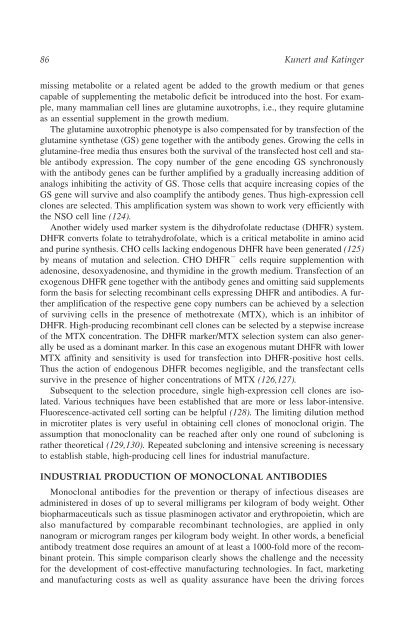Immunotherapy for Infectious Diseases
Immunotherapy for Infectious Diseases
Immunotherapy for Infectious Diseases
Create successful ePaper yourself
Turn your PDF publications into a flip-book with our unique Google optimized e-Paper software.
86 Kunert and Katinger<br />
missing metabolite or a related agent be added to the growth medium or that genes<br />
capable of supplementing the metabolic deficit be introduced into the host. For example,<br />
many mammalian cell lines are glutamine auxotrophs, i.e., they require glutamine<br />
as an essential supplement in the growth medium.<br />
The glutamine auxotrophic phenotype is also compensated <strong>for</strong> by transfection of the<br />
glutamine synthetase (GS) gene together with the antibody genes. Growing the cells in<br />
glutamine-free media thus ensures both the survival of the transfected host cell and stable<br />
antibody expression. The copy number of the gene encoding GS synchronously<br />
with the antibody genes can be further amplified by a gradually increasing addition of<br />
analogs inhibiting the activity of GS. Those cells that acquire increasing copies of the<br />
GS gene will survive and also coamplify the antibody genes. Thus high-expression cell<br />
clones are selected. This amplification system was shown to work very efficiently with<br />
the NSO cell line (124).<br />
Another widely used marker system is the dihydrofolate reductase (DHFR) system.<br />
DHFR converts folate to tetrahydrofolate, which is a critical metabolite in amino acid<br />
and purine synthesis. CHO cells lacking endogenous DHFR have been generated (125)<br />
by means of mutation and selection. CHO DHFR � cells require supplemention with<br />
adenosine, desoxyadenosine, and thymidine in the growth medium. Transfection of an<br />
exogenous DHFR gene together with the antibody genes and omitting said supplements<br />
<strong>for</strong>m the basis <strong>for</strong> selecting recombinant cells expressing DHFR and antibodies. A further<br />
amplification of the respective gene copy numbers can be achieved by a selection<br />
of surviving cells in the presence of methotrexate (MTX), which is an inhibitor of<br />
DHFR. High-producing recombinant cell clones can be selected by a stepwise increase<br />
of the MTX concentration. The DHFR marker/MTX selection system can also generally<br />
be used as a dominant marker. In this case an exogenous mutant DHFR with lower<br />
MTX affinity and sensitivity is used <strong>for</strong> transfection into DHFR-positive host cells.<br />
Thus the action of endogenous DHFR becomes negligible, and the transfectant cells<br />
survive in the presence of higher concentrations of MTX (126,127).<br />
Subsequent to the selection procedure, single high-expression cell clones are isolated.<br />
Various techniques have been established that are more or less labor-intensive.<br />
Fluorescence-activated cell sorting can be helpful (128). The limiting dilution method<br />
in microtiter plates is very useful in obtaining cell clones of monoclonal origin. The<br />
assumption that monoclonality can be reached after only one round of subcloning is<br />
rather theoretical (129,130). Repeated subcloning and intensive screening is necessary<br />
to establish stable, high-producing cell lines <strong>for</strong> industrial manufacture.<br />
INDUSTRIAL PRODUCTION OF MONOCLONAL ANTIBODIES<br />
Monoclonal antibodies <strong>for</strong> the prevention or therapy of infectious diseases are<br />
administered in doses of up to several milligrams per kilogram of body weight. Other<br />
biopharmaceuticals such as tissue plasminogen activator and erythropoietin, which are<br />
also manufactured by comparable recombinant technologies, are applied in only<br />
nanogram or microgram ranges per kilogram body weight. In other words, a beneficial<br />
antibody treatment dose requires an amount of at least a 1000-fold more of the recombinant<br />
protein. This simple comparison clearly shows the challenge and the necessity<br />
<strong>for</strong> the development of cost-effective manufacturing technologies. In fact, marketing<br />
and manufacturing costs as well as quality assurance have been the driving <strong>for</strong>ces


